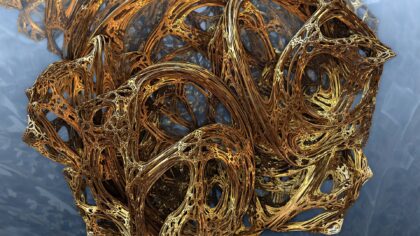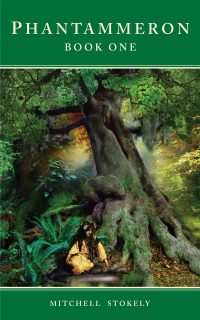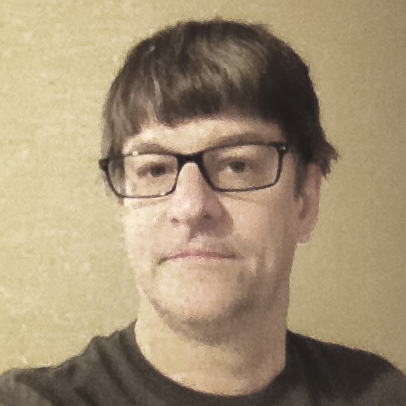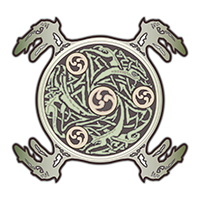In the novel Phantammeron Book One the main protagonist, Ana, falls into a pit. There at the bottom she discovers a cave and a dark pool filled with putrid black waters. An amorphous cloud filled with many eyes then rises from the waters, the evil Nothingness. Ana then has a conversation with that being and learns the terrible truth about herself, her family, the world, and its fate.

The horror and yet perfection of this intelligent being was fun to write about. It allowed me to dive down into the dark waters of my Self and ask questions and pose answers to myself that I had avoided many times in my life. As a middle aged man, having lived life more fully than the 20 something youth that conceived of the Phantammeron world in 1989, I felt it was time to answer a few of the mysteries of life through the book in a way that connected the story with my own recent and more mature belief systems. And so the conversation the girl in the novel has with this monster contained some thoughts and Truths about things often I felt Modern people failed to see.
For chatting with Nothingness is about conversing with the Nothingness inside ourselves and the evil and darkness and death that waits for us at the end of our lives we fear to see.
As Ana confronts the giant cloud of the Nothingness with questions, it takes the form of those she loves, most notably her mother. But towards the end it takes her own face. And so the Nothingness was to me a tool of self-reflection; about facing both the horror and beauty of ourselves. In her conversation with the monster, the Nothingness reveals to her that her own birth was in fact planned by him, telling Ana it parted the seas so her father Agapor could sleep with her mother An in the first chapters. It also tells her it parted the trees so she could escape death. And it tricked her own father into promising to bring her to him to die, which he had inadvertently done.
But it reveals a few darker things she doesn’t expect telling her that in fact the Nothingness and his brother the Emptiness were sent to destroy the world and the universe over and over, and that many had begged for death and release from those world’s. But the Nothingness tells Ana that they were not and would not be the source of the world’s demise. Its children would. And in so doing the Nothingness conveyed the anti-Christian idea that Evil is not outside in a Satan or a Hell, but inside each of us, in our own hearts. But not evil in a sense of “choice” or freewill but that all things are doomed to slay themselves,. For that darkness called Death lies in some spirit within us to die or fall by our own will. That seemed quite profound this being should say that. And so I pondered that idea for awhile…
The Nothingness then describes the fallen children of worlds prior as filled with the spirit of the Creative Flame, a spirit that is part of the Spirit Divine – that which fills all beings in the book, living and dead. But it is the Creative Flame, the spirit that creates great beauty, new children, and art, that also consumes us and that ultimately destroys the world, as the Essence Eternal, the Creator had himself been consumed.
And so in the book’s vast and consuming mythology I’m saying what gives us life and creates also consumes and dooms itself. And so Mankind is doomed by our nature. Our fate is to follow the fate described by the Viking Sages on Ragnorok, or end of the world battle between Gods and Giants.
But it is not a gloomy, tragic state. In fact the Phantammeron are based on my Christian belief that goodness triumphs and lives, and that people are inherently good and kind. And death is not an end but a continuing on, not to a heaven but towards new life, new children, new energy having nothing to do with our fate but of the inherent glory of God’s Creation which we celebrate.
Thus we experience being artistic creators and writers ourselves. Of course a dark being like the Nothingness cannot ever see or know this idea in such a hateful negative heart as he has. Like his ideas, these opposing ideas are basic to the Mythology of the Phantammeron world and so and form a part of a much larger spiritual source for the books many levels of meaning I have tried to construct that reflect back on the characters but also the deities in the novels and their connection to each other, the world, and their creations.
The Creative Flame as a “beyond spiritual” essence thus becomes such a device to trigger its dual and conflicting nature……a device for a larger concept about by own belief in creativity, artists, and creative people in general being closer to God (an idea William Blake, for example, believed in). In a sense, writing this conversation with the Nothingness was a voice inside me that spoke of conflicting and dualing Truths, at times. All writers must be all their characters and see these conflicts and accept and yet challenge them.
But in confronting this strange being and his dark but profound views, I had to call up my German ancestry, and my fatalistic, nihilistic side in order to develop them. The Nothingness then came to represent for me not pure Evil, but Determinism……that side of life that one has no power over. Like our DNA, we are born with it but we cannot change it. We cannot be something more than it. And so the Nothingness tells Ana, she has a choice – to kill herself and save the world its great suffering, or live and watch it unfold by releasing the Sacred Waters she carries into it that will doom it.
In life we are often told we have control over our fate. Conservative Americans hold a strange belief that we control our ability to get a job, get an education, etc. But that is a false premise. In fact we are all dependent upon huge corporations, our devious and controlling culture, the evils of money, limited by time, and cursed by laws and selfish politicians. We are heavily dependent on the pollution corporations and our fellow Man creates next door to poison us for profit. We are dependent on government to educate our kids and build highways and yet vet our lives. Much more may be said about his strange reality. But we don’t live on an island. We are interdependent. And so we are living in world that at times completely controls our fate. We may have good luck and by a little effort get a good job with a caring boss. We may avoid drugs and alcohol and other temptations and live a good life, even free of socialized religion or a faith we let consume us.
Those things alone really decide our fate in Modern America. But like the Creative Flame in all of us, we burn ourselves down, one way or the other, often entrapped by Evil people around us, and unwilling participants in the destruction of the Earth and thus ourselves. It is not to say life is not half full, too. Life is rich within these modern limitations. Money to the wise doesn’t buy happiness. But the Nothingness tells us the hard truth that we will destroy ourselves, as Ana will soon see in future books of the Phantammeron. The fate of Phantaia will be with the pool, whose waters she carries.
What brought me great insight in writing the Nothingness is the fact in time I saw he too was a pawn in a great play like Ana. And it told me inside me is a hopeful, free-loving child, like Ana, and yet a dark paternal evil, like the Nothingness, that surrenders to fate. It meant to me that conflict exists in us all and is part of being a WHOLE Human Being. And resisting and doing what is right even when entrapped by bad choices and bad people is a daily consideration.
The Nothingness, though all-knowing in the books, could never see that Truth. For it was a being that had imprisoned its own vast mind in the Great Beyond, its own prison, which I mention on Page 1 of the book, hiding from the burning lantern of the Sacred Light that the One Tree in the garden in Phantaia still blasted out from its center. For the light of Hope and Life was created to burn the Nothingness and keep his evil spirit at bay.
And so I have planted many secretive ideas like these in my novels, many most will never recognize but which I carefully considered when writing its narrative. For I have much more symbolism there waiting to be discovered, and many more secrets yet to reveal.
For example, who is the dark woman at the bottom of the black pool? And what is the dark ring meant to do?
At the end of the conversation the Nothingness tries to tempt Ana to take her own life by appearing as her lover, Ama, leading her toward the black pool where she will join with it and become one. But Ana pushes the tempting avatar of the Nothingness into the pool, where the Nothingness is drawn down into the waters by his mother, screaming. The Nothingness then is gone. But his purpose in setting up all the plots and fates of all the characters in Book One was served. And his Truth and the Truths about the world and its fate, was revealing, even to me. For that being seemed to reveal to me the writer things I had never considered in the Phantammeron story. And so I thank the Nothingness for his solemn words though hateful and destructive. Yet I trusted Ana to know her heart and see through that dark time.
But these ideas made the hairs on the back of my neck stand up. Such is the thrill of writing novels like these that Truth comes from such tales we conceive in the shadows of a room…
– the Author



